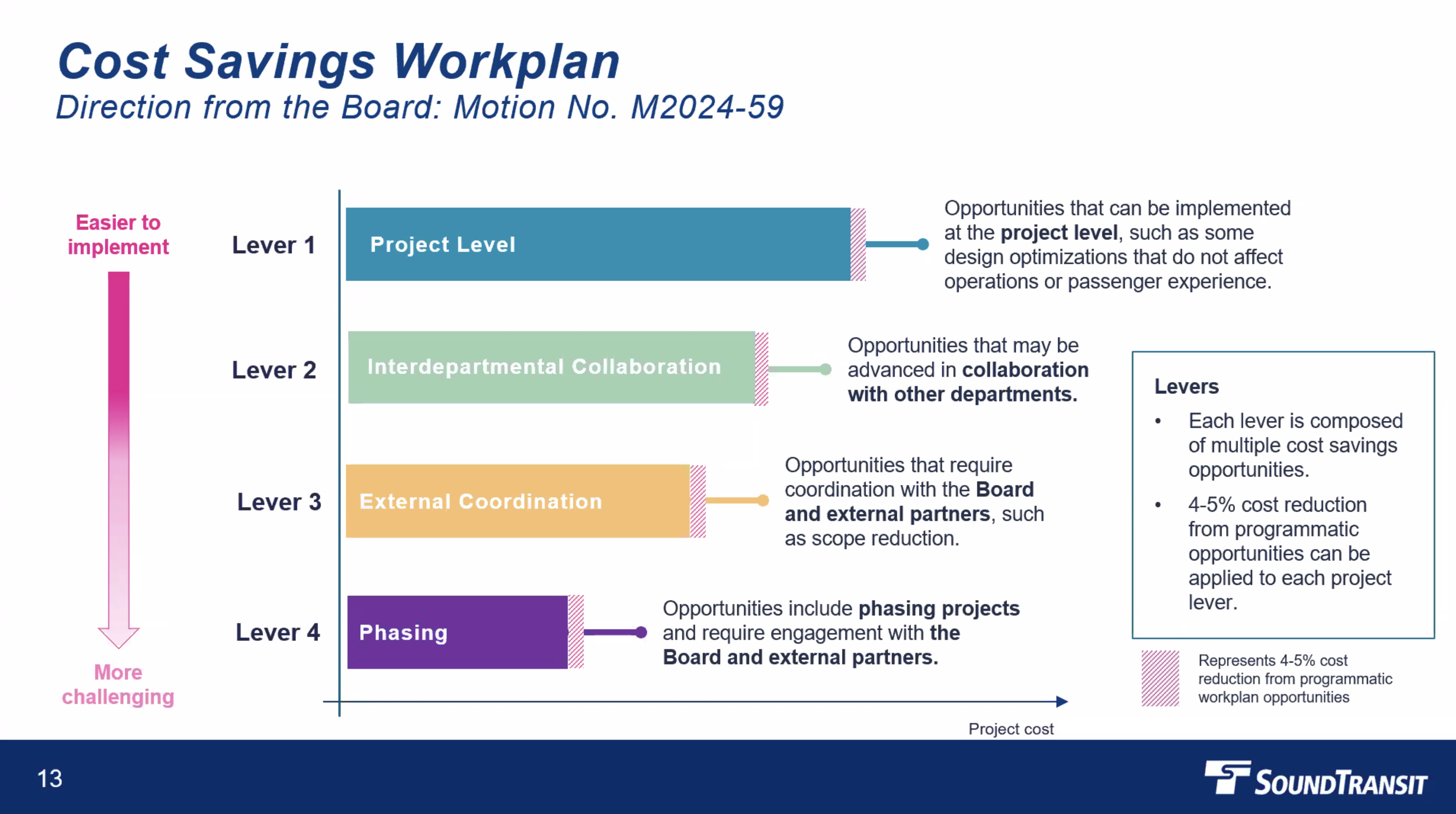Sound Transit confronts staggering $20-25 billion shortfall, launches "Enterprise Initiative" to secure ST3 future
A slide from the presentation made to the Sound Transit Executive Committee on Aug. 28 summarized the pressures facing the agency to complete the West Seattle and Ballard Link Extensions.
Thu, 08/28/2025
Sound Transit is facing a formidable financial challenge, with its ambitious ST3 mass transit expansion plan grappling with an estimated $20 to $25 billion affordability gap over the next two decades, the agency announced at its August 28, 2025, Board of Directors meeting. In response, the Board officially launched its "Enterprise Initiative," a comprehensive agency-wide effort to bring the ST3 program back to affordability and deliver on its promises to voters.
Sound Transit Chair Dave Somers opened the meeting by acknowledging the long-known "affordability issues with the ST3 plan" that had previously lacked precise quantification. He emphasized the Enterprise Initiative's role in providing the necessary "tools to address the affordability gap in a responsible way and one that serves the entire region".
CEO Constantine elaborated on the severity of the situation, stating, "if we just do nothing, we will eventually see our program become unaffordable." He confirmed the magnitude of the gap, noting it is "something on the order of 20 to 25% over the course of 20 years" in the long-range financial plan. However, he expressed optimism, asserting, "we have options... I am very optimistic that we will be able to provide the tools you need to be able to deliver on our promise to the voters and maybe even create a better system".
The identified cost pressures fall into three main categories, as detailed by Alex Krieg, Director of Enterprise Planning, and other staff members:
• Capital Program Costs: An increase of $14 billion to $20 billion in 2025 dollars, or $22 billion to $30 billion in year-of-expenditure dollars, impacting projects like Seattle Ballard, Tacoma Dome, and Everett.
• Service Delivery Costs: An additional $5 billion in year-of-expenditure dollars for safe, reliable service, driven by the need for new light rail vehicles, system reliability investments, and higher operational and maintenance costs.
• Finance Challenges: A $4 billion to $5 billion impact in year-of-expenditure dollars from lower sales tax and fair revenues, coupled with increased borrowing costs.
Terry Mestas, Deputy CEO for Capital Delivery, highlighted historical inflation, noting that highway construction costs have surged 71.5% since the end of 2020, and engineering services have doubled in price over the last four years, severely impacting project budgets. Sound Transit acknowledged that previous cost estimates, based on parametric or unit cost library methodologies, did not fully reflect actual project costs, which are now being determined through more detailed "bottoms-up estimates" as projects reach 10-30% design maturity.
The Enterprise Initiative marks a departure from past "realignments" by adopting a comprehensive approach that integrates capital expansion, operations and maintenance, and finance under one umbrella. The Board adopted principles to guide this work, which will lead to a new comprehensive framework this fall, an updated ST3 system plan by Q2 2026, a new regional transit long-range plan in Q3 2026, and an updated long-range financial plan in Q4 2026.
Independent capital delivery expert Ken Johnson stressed the importance of maintaining momentum despite the financial challenges. "Delay is the biggest enemy in terms of cost increases," Johnson remarked, urging the agency to "keep find ways to keep that going. The projects that are in goal mode while you're doing this analysis".
Board members engaged in robust discussion, underscoring both the gravity of the situation and their commitment to the ST3 vision.
• Board Member Claudia Balducci acknowledged, "This is going to be a very challenging time for us... Our fundamental challenge is to deliver the system the voters approved." She encouraged asking "big questions," including the need for a second downtown tunnel and exploring faster, more cost-effective project delivery strategies.
• Board Member Shannon Braddock viewed the challenges as "opportunities... if we respond with creativity and transparency," while warning against being "paralyzed by these challenges and stop the forward momentum".
• Board Member Christina Walker affirmed, "my top priority is delivering on our promise to the voters of Tacoma and Pierce County," adding that "the problem isn't insurmountable" and that Sound Transit investments are "about building a future that connects people to jobs, school, essential services, health care".
• Board Member Dan Strauss remarked, "It's clear that we have hard decisions ahead of us. Successful sequencing will be critical... Phasing by itself will not serve any of us or the region because again phasing is another way of saying delay," emphasizing that the current situation is "an opportunity to take a hard look".

A proposed amendment to the Enterprise Initiative principles, introduced by Board Member Bruce Harrell, sparked considerable debate. Harrell argued that the amendment, which sought to incorporate considerations for "future growth" and "major employment and population centers," was a "friendly amendment" that aligns with the agency's historical planning principles since 1993 and is "not pressing a thumb on a scale". The amendment was narrowly approved by a roll call vote of eight to six.
Public comments also reflected the community's concerns. Marilyn Kennell from West Seattle requested a pause on the West Seattle Link extension until ST3 is realigned, citing the "urgent need to rethink ST3" and the project's estimated $7 billion cost. Brian Chow highlighted the Enterprise Initiative as a "crucial shift" towards financial sustainability and equity.
Despite the "terrifying reality of future projections" due to unprecedented inflation and supply chain disruptions, Chair Somers concluded by reaffirming the agency's commitment to tackle these issues proactively. "We are going to achieve the objectives of the Sound Transit three plan," he stated, adding that the staff is dedicated to providing the Board with the necessary tools to make informed decisions


